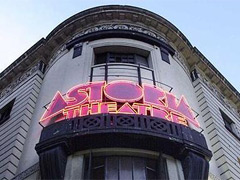


Sometimes places make such an impact there is mourning, protesting, or relief for all concerned. We take a look at the venues that left their mark, long after they disappeared.
The Colony Room
The Colony Room was a private member’s bar owned by Muriel Belcher, known for her sharp temper and acerbic wit. Jazz musician George Melly and artist Francis Bacon were regular patrons, whom Belcher counted as close friends.
It opened in 1948, with a licence to serve alcohol from 3 pm in the days when pubs had to close after lunchtime. It became a hedonistic retreat for many actors and literary figures, some of whom had been introduced to the club by Bacon himself, as Belcher paid him a weekly wage to bring in new members. They were mostly a hard-drinking lot, including Jeffrey Bernard (who was barred on several occasions but still tried to sneak in via a ladder), John Hurt, Tallulah Bankhead and Dylan Thomas. In a recent book on the club by Sophie Parkin she claims she’s glad she never became a member, for the dire consequences it would have had on her health.
Belcher passed away in 1979 but the Colony Room stayed open until 2008, although it was never quite the same. The original Soho bohemians were replaced by the likes of Tracey Emin and Damien Hirst, and members of the Primrose Hill set. Today the building houses fashionable eatery Ducksoup.
The Four Aces
Throughout its lengthy history, the Four Aces in Dalston was a vaudeville theatre, picture house, live music venue hosting reggae nights and home to Labyrinth, a rave night. Up until the inception of Labyrinth in the late 80s the club had been north London’s main showcase for black musicians, with Stevie Wonder, Jimmy Cliff and Bob Marley performing. Labyrinth is forever linked to the early days of jungle and hardcore, its cavernous corridors adding to the trippy, multi-sensory experience of clubbing.
Hackney council purchased the building in the mid-90s, with a view to re-opening nearby Dalston Junction station. The tenants were evicted and the building was boarded up, allowing rain to get in and destroy the inside. A campaign was mounted to prevent the club from closure and subsequent demolition, but to no avail, in 2009 it was torn down. Not only were complaints voiced over the closure of an important cultural stalwart of the area, but the building itself was of historical importance – had the council not allowed it to fall into neglect English Heritage would have deemed it a listed building. Blocks of flats were erected in its place, of which only a very small percentage are affordable housing. \n\nThe Marquee Club
Jimi Hendrix, the Rolling Stones, David Bowie, Led Zeppelin, the Who and the Animals played very early gigs here. Important record deals were signed, and the club was to witness to events like Pete Townshend smashing up his guitar on stage.
The Marquee moved locations on several occasions, but its most glittering period was between 1964 and 1988, when it was based on Wardour Street (today the site is occupied by Floridita). It saw the birth of many movements, including the psychedelic rock scene and punk.
Over the years there have been several attempts to resuscitate the Marquee. The Marquee on Leicester Square run by Plum Promotions featured newcomers and offered very cheap entry; its most recent incarnation – and perhaps the least remarkable – lasted just five months, in Soho’s Upper St. Martins Lane. There are no plans to re-open it.
\n\nGossips
Gossips, located in the basement of 69 Dean Street, had its heyday during the new wave and goth eras. At one point Steve Strange, frontman of Visage, greeted punters on the door, and an unknown Boy George worked in the cloakroom. It was one of the first venues to have themed events, like David Bowie nights, reggae nights with David Rodigan and blues nights with Gaz’s Rockin’ Blues. Incidentally the latter still runs to this day, and is London’s longest running event.
The club managed to soldier on till 2009, hosting indie bands, many of which were up and coming, but throughout the noughties it failed to make an impact. Today 69 Dean Street is home to the Dean Street Townhouse, owned by the Soho House Group.
The Astoria
The Astoria on Charing Cross Road was one of London’s biggest and most important live music venues since opening in 1976 till its closure in 2009. Previously a warehouse before becoming a theatre, it would become known primarily for staging rock acts, with major bands like Radiohead and Manic Street Preachers having performed and recorded live DVDs here, to name just two.
In its last few years it was taken over by the Mean Fiddler group. In 2009 the Astoria was demolished to make way for the Crossrail expansion. Other venues that had to be torn down for the expansion were Ghetto, Sin, Astoria 2 and Metro.


